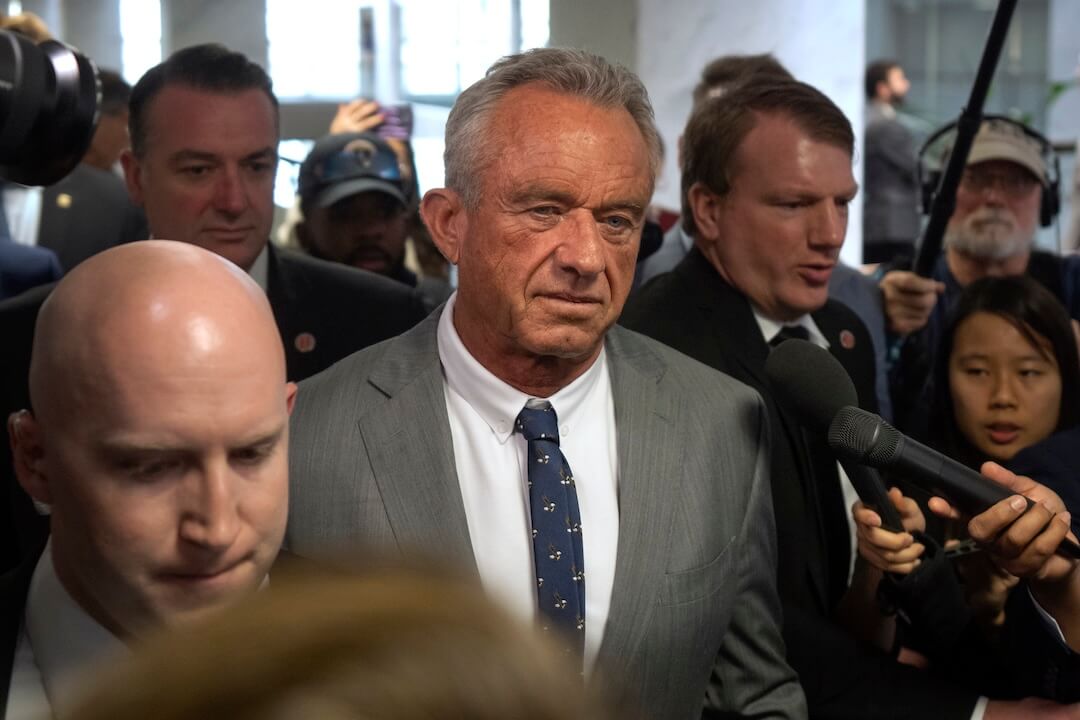Today, The Washington Post went further than any mainstream news organization has ever gone before in showing the brutality and devastation of something that plagues this nation: mass shootings.
This morning, The Washington Post published “Terror on Repeat.”
It’s at this point, you should be warned: The Post piece is extremely graphic and some may find it disturbing. The Post looks back at 11 mass shootings in which the weapon used was an AR-15. Just the names of the places bring back horrific memories: Parkland, Florida, and Uvalde, Texas, and Newtown, Connecticut. The Post’s project includes the shootings at a concert in Las Vegas, a movie theater in Aurora, Colorado, and a synagogue in Pittsburgh.
To have the most impact, the Post told the story through photos, videos and the words of those who have survived these horrific shootings. The photos are jarring. For example, there are images of schoolrooms at Robb Elementary in Uvalde moments after dead children were removed. Videos are hard to watch, such as one that includes the cries of students inside Marjory Stoneman Douglas High School in Parkland, Florida, as gunshots are heard.
On Wednesday, I spoke with Washington Post executive editor Sally Buzbee. Buzbee told me, “We know it’s very sensitive material and very disturbing and we know it will be disturbing to people.”
In some ways, that’s the point: for people to see what mass shootings look and sound like and, specifically, the damage done by the AR-15. Buzbee emphasized during our conversation that the Post was “not aiming for the shock value.” However, she told me, “News organizations rarely publish extremely graphic content around these things. And we just felt that there was a lack of understanding of what actually happens in these shootings. We’re really just trying to say what the destructive power is and what these (weapons) actually do. I think our main hope is people just get a more factual, realistic view of what happens in these highly destructive mass shootings.”
In March, as a part of a series on AR-15s, the Post published a powerful story about what an AR-15 does to the human body. Through graphics and 3D animations, the piece showed the devastation done by a weapon so often used in mass shootings.
But some readers said the Post should go further, that it should show the realities of what the AR-15 really does, the damage it inflicts, the pain it causes and leaves behind.
So for the past six months, through the work of more than 30 journalists, the Post put together this important project.
In an editor’s note to readers published Thursday, Buzbee wrote, “We filed more than 30 public records requests in jurisdictions that had investigated AR-15 shootings since 2012, the year that included massacres at a movie theater in Aurora, Colo., and at Sandy Hook Elementary School in Newtown, Conn., seeking medical examiner records, crime scene photographs, police body camera footage and other investigative files. Most of our requests were rejected, with officials citing ongoing investigations or local laws preventing the release of such information. Officials in some communities released documents in response to our requests, including Aurora, Dayton, Ohio, and Las Vegas. Our reporters also gathered court records and other information that had previously been made public, and scoured social media and websites for photos and videos that may have surfaced after AR-15 shootings. They interviewed survivors and first responders willing to share their experiences, searched for official transcripts of witness testimony and compiled relevant interviews conducted in the past by Post journalists — amassing firsthand accounts that are crucial to this story.”
Buzbee then wrote that the Post separately obtained a collection of evidence from the shooting in Uvalde compiled by state and federal police and not previously made public.
Then came the grueling part: examining the photos and videos and deciding which ones should be published. The Post reached out to many of those who lost loved ones and, in particular, those who lost children. They spoke with community leaders and advocates on all sides. Some reached even said they were open to the Post showing the dead bodies of their loved ones.
Buzbee told me, “We tried to figure out what was respectful that also showed the reality of these shootings. And there is blood. And there is an enormous amount of graphic damage, but we ultimately decided it was too far to show bodies. We wanted people to be able to see this and not recoil.”
Only one photo — from the Las Vegas shooting — shows actual dead bodies. But the image is from such a distance that no one is recognizable.
Still, what the Post did publish is hard to look at. Buzbee, however, said the Post really wanted to show the commonalities among the shootings involving AR-15s.
“We’re not trying to create things purely for shock value,” Buzbee said. “What we really sought to do here was to show just how destructive, how profoundly devastating this type of shooting with this type of weapon is. But not go so far that the entire conversation circulated around, ‘Oh, you’re just trying to shock us.’”
On the other hand, the Post also wanted to be careful to not show so much that it would desensitize its audience to the violence. It had to be cautious in selecting just the right material to publish, knowing this might be the only opportunity it has to run such a piece.
“We did worry that every time you go further into something you desensitize people and so we felt we needed to be enormously careful and responsible if we were going to do this,” Buzbee said. “We talked about it a lot. We showed it to various people. We communicated very deeply with the families and tried to learn from all those experiences as we went along. We went to great lengths with the warnings to our readers — warnings that were more detailed, but more approachable. Our goal is not to desensitize people to violence.”
Not only did the Post alert the loved ones of victims about the project, but it also showed the project to a test audience to get their reactions. A buzz about the project started to filter through social media on Wednesday, with one Uvalde parent encouraging people to not read or share it.
“Many families support this kind of coverage,” Buzbee said. “Other families do not support this kind of coverage. I think that we respect both points of view and mean no harm to any family, and feel deep compassion. … What our goal here was to ensure that no family felt that we were not listening to them.”
Surely, a debate will follow about whether or not the Post went too far or, some could argue, not far enough.
Kelly McBride, Poynter’s senior vice president and chair of the Craig Newmark Center for Ethics and Leadership, told me, “There isn’t a parent in America who doesn’t fear the prospect of their child being caught in a shooting involving an automatic weapon. The Post has done a significant amount of reporting on this topic and they’ve found ways both in the past and in this new package to tell the story that both informs the audience and respects the varied capacity that people might have to take in difficult images. It would be cowardly to avoid pushing for a deeper understanding, simply to avoid criticism.”
The Post is hoping this is not the end of the conversation, but a continuation. Today’s project also includes this story: “As mass shootings multiplied, the horrific human cost was concealed.”
Buzbee wrote in her editor’s note, “We realize this story will be disturbing to many readers, but we believe that publishing these images gives the public a new vantage point into the pattern of AR-15 mass killings in the United States. We hope that readers will share their feedback in the comments section at the end of the story.”
Readers assuredly will.
On a personal note, I was shaken by the piece, a few of the photos and one video in particular. But The Post did its job responsibly.
There was a part of me that wished the Post had gone even farther, but I have never lost a loved one in a mass shooting.
In the end, this project is difficult to look at. It’s supposed to be.
Meet the new boss …
Same as the old boss?
Wednesday was officially Rupert Murdoch’s last day as chairman of News Corp., the company that includes publications and networks such as Fox News, The Wall Street Journal and the New York Post. Rupert’s son, Lachlan Murdoch, who is the CEO of Fox Corp., will take over for his father. However, there’s a belief that the 92-year-old Rupert Murdoch will still have a hand in the business.
At News Corp.’s annual shareholder meeting on Wednesday, the elder Murdoch said, “As you know, I am moving to the role of chairman emeritus, and Lachlan will become the sole chair of News Corp. Lachlan is a principled leader, and a believer in the social purpose of journalism. I hope to continue an active role in the company.”
So will anything be different with Lachlan, technically, running the show?
Brian Stelter, who has a new book about Fox News, told Terry Gross of NPR’s “Fresh Air,” “Well, Rupert Murdoch is, in his heart, a newspaper man. He believes he is a journalist. Yes, he comes at it from the right. He has certain very strongly held opinions. But he deeply cares about his newspapers and, to some degree, Fox News. His son Lachlan is, No. 1, in some ways, more conservative and, No. 2, much more business-minded. He’s not nearly as interested in politics. He’s not nearly as interested in the polling. He’s a lot more interested in how much money he can rake in from campaign ad spending at his stations and on Fox News. So he comes to this as a businessman, and I suspect that means Fox is going to continue to be this beating heart of the GOP, supporting whoever becomes the nominee, most likely Trump this year.”
Making the rounds

MSNBC’s Rachel Maddow, left, appearing on CBS’s “The Late Show with Stephen Colbert.” (Courtesy: CBS / @skpnyc)
This was something: Three NBC News/MSNBC on-air personalities were featured on late-night talk shows on Wednesday.
Rachel Maddow appeared on CBS’s “The Late Show with Stephen Colbert”; Ari Melber appeared on NBC’s “Late Night with Seth Meyers”; and Steve Kornacki was on Comedy Central’s “The Daily Show” with guest host Leslie Jones.
While Colbert’s show was taping, it was learned that House Speaker Mike Johnson was able to avoid a government shutdown, but only because of help from the Democrats.
After taking off her glasses and rubbing her eyebrows, Maddow deadpanned, “I’m sure Mr. Johnson is very smart and capable and knows exactly what he’s doing.” Then she said, “But he got this job because the previous guy (California Rep. Kevin McCarthy) was driven out with pitchforks and torches for having had the temerity to speak to political opponents rather than wishing them dead, and now he (Johnson) needs his political opponents in order to keep his job. We all know how this ends.”
Maddow then criticized the Republican Party, saying it’s “not a party that is trying to govern.” She added, “Now we are going to keep the government open. It is because the Democrats came to the rescue and said that we should. But this is the Republican Party still not even wanting to keep the government going because they don’t believe that governance is what we need in this country; they believe we want a strongman form of government under a guy who just says what he wants and it happens.”
CNN drama

David Zaslav, president and CEO of Warner Bros. Discovery, shown here in June in Los Angeles. (Jordan Strauss/Invision/AP)
If you’re into juicy, behind-the-scenes media drama, here’s a piece for you: The New York Times’ James B. Stewart and Benjamin Mullin with “Behind CNN Turmoil, a Series of Shattered Friendships.”
The story looks at how David Zaslav, the chief executive of Warner Bros. Discovery (which owns CNN), had friendships with several people who ended up getting fired from CNN. We’re talking about former heads Jeff Zucker and Chris Licht, as well as on-air talent Don Lemon and Brian Stelter. The Times reports that Zaslav and Zucker were best friends, but that didn’t save Zucker. The two no longer talk or text daily like they used to.
The story reveals some of the friendships that Zaslav had with certain people, and then what happened before and after they were fired. It also goes into a bit of detail about how they were fired.
There is a belief that Zaslav was going to eventually replace Zucker, but then Zucker was let go before Zaslav had a chance after it was discovered that Zucker was having a consensual relationship with one of his top lieutenants. The Times story reveals how the two met after the fact when they happened to be staying in the same hotel in Miami Beach. Reportedly, Zucker told Zaslav that he was coming out of the most difficult periods of his life and that all of his closest friends were there … “Except me,” Zaslav said, finishing Zucker’s sentence.
The two apparently patched things up. Yet later, the Times reported, Zaslav belittled Zucker as a weakling who had tears in his eyes when they met.
There’s much more to the behind-the-scenes stuff, so it’s a good and informative read.
Also in the Times, this story about Zaslav from Stewart, Mullin and Jonathan Mahler: “How David Zaslav Blew Up Hollywood.”
Inspirational words
This week, Benjamin Hall, the Fox News reporter badly injured while covering the war in Ukraine, was presented with the Kenneth Y. Tomlinson Award for Courageous Journalism at the 30th annual The Fund for American Studies journalism awards dinner in New York.
During his speech, Hall talked about the two colleagues — photographer Pierre Zakrzewski and Ukrainian Oleksandra “Sasha” Kuvshynova — who were killed while working alongside him on March 14, 2022. Hall lost his right leg below the knee, much of his left foot and the sight in his left eye. His left thumb was blown off, his skull was dented and he was burned over much of his body.
Hall said, “People ask me, if you could heal yourself up, get rid of the injuries, but never have done a day’s work of journalism, would you take it? To which I say no. Absolutely not. I think that what we do, what every journalist out there is doing right now is essential.”
He recognized other journalists covering the war in Ukraine and the war between Israel and Hamas. He mentioned Wall Street Journal reporter Evan Gershkovich, who is being detained in Russia on allegations that he’s a spy — allegations vehemently denied by the U.S. government and the Journal.
“It’s really noble,” Hall said, “and I stand here not because I was injured, or because of my experiences, because I stand here just to tell you all that journalism is essential. Supporting journalism is essential. It is the only way to encourage people to change the world. And there’s only one way of doing that as a journalist. And that is by going into the field, looking people in the eyes. Smelling what it’s like, feeling it. There is no other sense of journalism.”
Sad news
Terry Taylor, the first female sports editor of The Associated Press, has died. She was 71. She had been battling breast cancer since 2013.
Julie Pace, senior vice president and executive editor of the AP, told the AP’s Ronald Blum, “Terry was truly a trailblazer in journalism, paving the way for so many women to ascend into leadership, both in sports departments and throughout the industry. Her legacy at AP has been an enduring one, and that will no doubt continue.”
Taylor ran the AP sports department from 1992 until 2013.
Jim Litke, an AP reporter from 1978 to 2022 and longtime national columnist, told Blum, “You had to work alongside her to appreciate how many barriers she knocked over day after day, and she did it with joy and plenty of humor, but nobody had sharper elbows. Whether it was wrangling a generator from a hotel manager in San Francisco the night an earthquake rocked the World Series, or walking into the chairman’s office at Augusta National to deliver her point in person, Terry never stopped trying to make every story she touched better. She dared us to follow her lead, to push and pull at every loose thread, and made all of us better reporters and even better people in the bargain.”
Media tidbits
- Variety’s Brian Steinberg with “Univision Anchor Leon Krauze Exits in Wake of Network’s Controversial Trump Interview.”
- From the let’s-see-if-it-works-this-time department, Variety’s Todd Spangler with “Gawker Sold to Founder of Singapore’s Caldecott Music Group: ‘It Has the Opportunity for Reinvention.’”
- On Politico’s website, another excerpt from Brian Stelter’s new book about Fox News, “Network of Lies,” which is out this week: “Tons of Crazy’: The Inside Story of How Fox Fell for the ‘Big Lie.’”
- A legal battle in Philadelphia. PhillyMag’s Victor Fiorillo with “KYW News Anchor Carol MacKenzie Files Gender Discrimination Lawsuit Against Station.”
- Front Office Sports’ Michael McCarthy reports Jason Aidoo will succeed Raina Kelley as boss of ESPN’s Andscape, the site devoted to the intersection of Black culture and sports. McCarthy writes, “Aidoo, who had run business operations for Andscape, will add editorial oversight to his responsibilities but will not pick up her editor-in-chief title, said sources.”
Hot type
- From The New York Times Opinion, text by Judith Surber and photographs by Justin Maxon: “Addiction Ravaged My Family and Tribe. I’m Fighting to Get Them Back.”
- The Athletic’s Brendan Quinn with “Rick Pitino is obsessed. He doesn’t have time to stop.”
More resources for journalists
- Subscribe to PolitiFact’s weekly newsletter. Get facts delivered straight to your inbox.
- Poynter ACES Introductory Certificate in Editing (Online) — Enroll now.
- How Any Journalist Can Earn Trust (Self-directed course) — Enroll now.
Have feedback or a tip? Email Poynter senior media writer Tom Jones at tjones@poynter.org.
The Poynter Report is our daily media newsletter. To have it delivered to your inbox Monday-Friday, sign up here.







